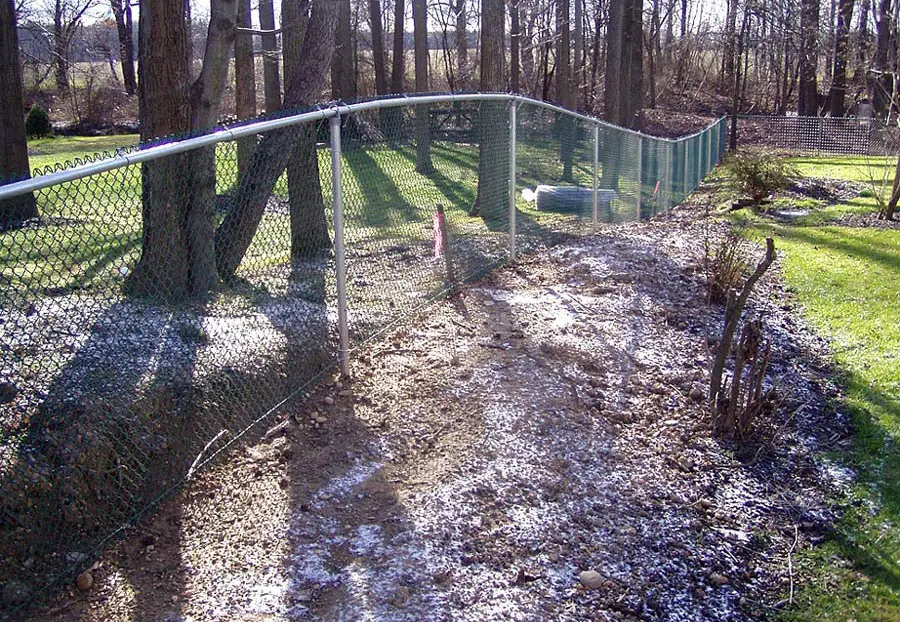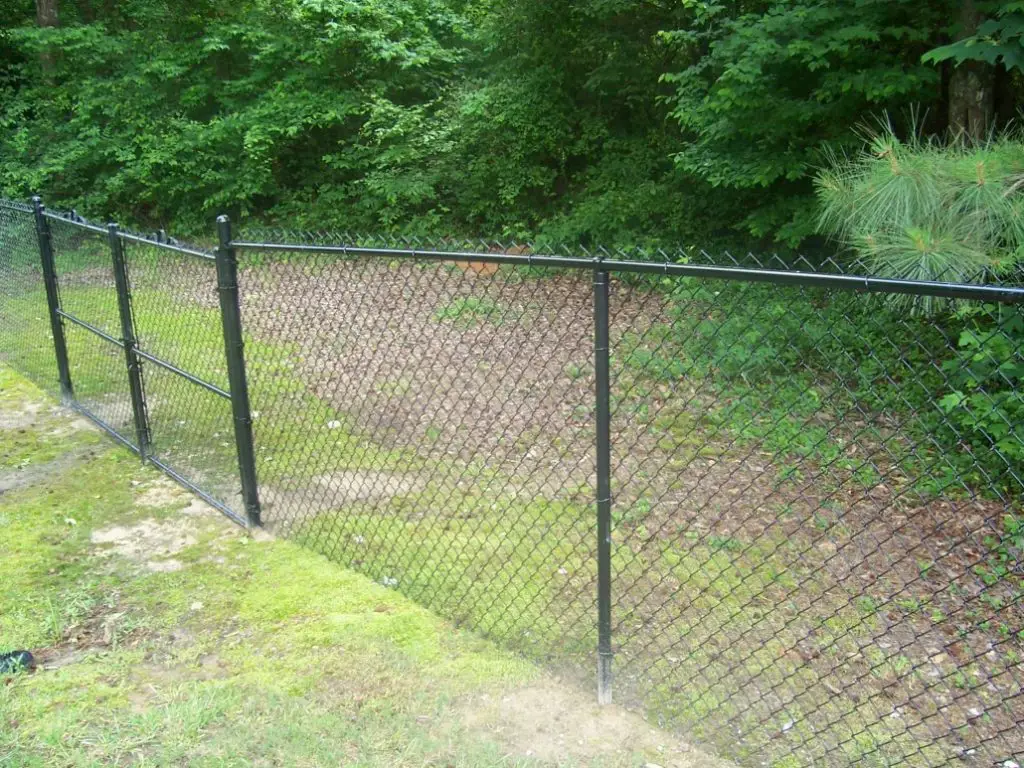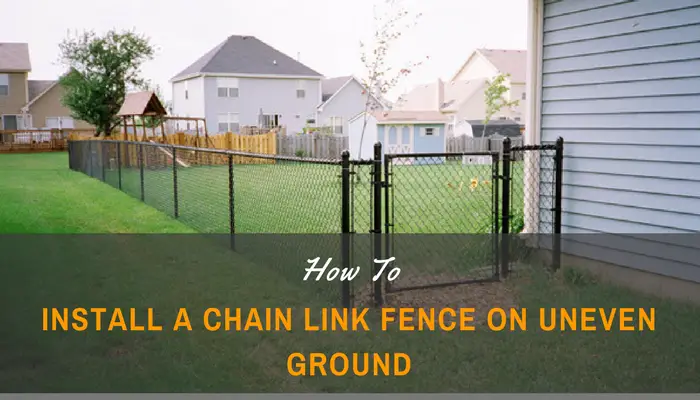How to Install a Chain Link Fence on Uneven Ground
How to Install Chain Link Fence on Uneven Ground
Chain link fences are typically created to demarcate property boundary, ward off trespassers, and protect land against wild animals. Since their construction is less time and labor intensive compared to constructing concrete walls, they are preferred by homeowners and contractors.
Too often, the main dilemma in constructing fences has to do with the uneven ground surface in one’s property. To work around this issue, you will need to have comprehensive knowledge of fence building, most especially if you will be using chain link metal.
In this article, you will learn about the different steps needed when constructing chain link fences on uneven ground.

Soure: backyard.cecilash.com
What You Will Need
- Chain link fences (the length will vary depending on the area of your property)
- Cement
- Metal clips
- Metal crowns
- Metal poles
- Hole digger or shovel
- Length of string or level
Preparation
Once you have decided to put up a fence around your property, there a number of pre-installation steps that you need to complete. Here are some of them:
- Obtain an accurate map of your property. You may obtain this through your local land assessor's office or you may use your own copy of your land title.
- Apply for building permits if necessary. Read about building codes and construction laws of your town or city.
- If possible, inform neighbors and owners of neighboring properties of what you will be doing to set proper expectations in the neighborhood.
Fence Post Construction
For a perimeter wall or fence to be sturdy, you will need to build equally-reliable fence posts first. The fence posts will act as anchors for your chain link fence.
You need to create two types of fence posts: terminal posts and line posts. Terminal posts are larger in diameter and are located on each corner of your property. Line posts have a smaller diameter and are located between each terminal post.

Soure: keystonefences.com
- Ask for a post spacing chart from your local hardware supply store. Follow the recommended spacing of line posts depending on your property's perimeter.
- Once you have determined the different locations for each post, mark them with stakes, and then it’s time to start digging. You may use an electric hole digger at this point or you may use your own hands.
- For terminal posts, dig holes that are 10 inches in diameter at the top and then flare out to 12 inches at the bottom. Also make sure that your terminal posts are 2 inches taller than your chain link fence.
- For line posts, dig holes that are 8 inches in diameter at the top and then gradually increases to 10 inches in diameter at the bottom. Also remember that the line posts should be 2 inches shorter than the height of the chain link.
- Mix cement and pour them into the terminal holes first. Then, put up the metal posts in the holes. Adjust pole height accordingly until the cement hardens.
- Tie a string 4 inches below the top of a terminal post and then run the string to all other terminal posts.
- Then, pour cement on other line posts and place the metal poles accordingly.
- On the part of your property where slopes appear, adjust the line posts’ top portion to meet the line of string running above it. All the line posts should stand at equal height relative to the line of string above it especially on the areas with uneven ground.
- Allow the cement to harden for a day.
Chain Link Installation

Soure: pacificfencewholesale.com
After the concrete on the fence posts have hardened, you may now begin unrolling the chain link fabric. To do this, here are the steps:
- First, un-roll only a small length of the chain link fabric (about one foot).
- Start at a terminal post and begin attaching the edge of the chain link fabric to the post judging metal wires and latches.
- Stretch out the chain link fabric to the next line post and attach metal latches at the point of contact between chain link fence and metal post.4. Repeat these steps on all line posts and terminal posts.
- Repeat these steps on all line posts and terminal posts.
- Once all the chain link material has been laid out around the perimeter, attach cap crowns on top of each fence post. This secures the metal posts to the chain link fabric. Repeat this step on all fence posts.
- Viola! You now have a completed chain link fence specifically suited for uneven ground surfaces.
Note: Constructing chain link fences by yourself is not an easy task. But with diligent research and practice, there is no doubt that you will be able to complete it. And with any construction job, always remember to follow safety precautions and do not hesitate to ask for professional help if you think something is wrong with what you are doing.
Installing a chain-link fence on uneven ground can seem like a challenging task, but with the right tools, materials, and preparation, it can be done easily and efficiently. The first step in installing a chain-link fence on uneven ground is to map out the property and determine the placement of your fence. You’ll need to ensure that the fence posts are placed in the proper locations and that the height of the fence meets any local regulation. It’s important to hire a professional contractor or to get the help of a professional if you’re unsure of the installation process. With the proper preparation and instruction, you’ll be able to install the chain-link fence on your property with ease. The most important thing to keep in mind when installing a chain-link fence on uneven ground is to properly dig holes for the terminal and line posts, and to pour concrete for the posts to harden in. This will ensure that the fence is stable and can accommodate taller sections if necessary. We will guide you through each step of the fence installation process, from digging the post holes to attaching the edge fabric to the fence posts. We will also cover important tips such as adjusting the height of the fence to accommodate any slope, and attaching tension bars to ensure the fabric is stretched properly. Don’t hesitate to select the type of fence that best suits your needs and follow the instruction carefully.
Understanding The Challenges And Preparing For Installation
Installing a chain link fence on uneven ground can present a number of challenges for homeowners. One of the main issues is ensuring that the terminal posts, which mark the corners and ends of the fence, are level and plumb. This can be difficult when the ground is sloped or has a bias.
To prepare for installation, the first step is to obtain any necessary permits. Then, it’s time to locate the property lines and mark the area where the fence will be installed. The homeowner can then tie a string along the edge of the chain link fence to mark the planned location.
Next, using a hole digger, the homeowner will need to dig holes for the terminal posts. The diameter of the holes at the top should be smaller than the diameter at the bottom, so that the posts will be stable when cement is poured in.
Once the holes are dug, the homeowner can construct the fence by installing the sections, cutting the wire to fit, and attaching the metal latches. It’s important to keep in mind that when installing the fence on a slope, the wire will need to be cut at an angle to maintain the gradual slope of the fence.
When installing the chain link fence on uneven ground, the homeowner must pay attention to the spacing between the posts, and use the metal ties to keep the fence tight and secure. It’s important to avoid any excess space between the posts, as this can cause the fence to sag or become unstable.
Though the process of installing a chain link fence on uneven ground may seem daunting, with proper preparation, the homeowner can construct a stable and secure fence. Remember to pay attention to restriction and permit before starting digging holes.
Step-by-Step Guide for Installing a Chain Link Fence on Uneven Ground
- Start by measuring and marking the area where you want to install the chain link fence.
- Use a level to determine the slope of the ground. If the slope is more than 10 inches over a 6-foot distance, you will need to install the fence on a slope.
- Determine the location of the fence posts. On uneven ground, it’s important to use posts that are the same diameter at the top and bottom, to ensure stability.
- Dig holes for the fence posts. The holes should be about two-thirds the length of the post, and should be wider at the bottom than at the top.
- Insert the posts into the holes and make sure they are level. If the ground is uneven, you may need to use smaller diameter posts at the bottom of the hole to ensure a stable fit.
- Mix cement and pour it into the holes to secure the posts in place. Make sure the posts are level as you pour the cement.
- Once the cement has set, attach the chain link fencing to the posts using fence ties or other appropriate hardware.
- Finally, install any additional features, such as gate posts or gates, to complete the installation of your chain link fence on uneven ground.
Tips for Achieving a Secure and Level Fence
- Use metal fence posts instead of wood. Metal posts will be more durable and less likely to rot or warp, which can affect the level of the fence.
- When digging holes for the fence posts, make sure they are deep enough so that at least one-third of the post is underground. This will provide added stability to the fence.
- Check the slope of the ground with a level, and make sure to adjust the postholes accordingly. If the slope is too steep, you may need to install the fence on a slope.
- Use a level to ensure that the posts are level as you install them. This will help ensure that the fence is level and secure.
- Consider using concrete or cement to secure the fence posts in place. This will provide added stability and ensure that the posts do not shift over time.
- Install additional support posts along the fence, especially if the fence will be exposed to strong winds or other forces.
- Use proper hardware to attach the chain link fencing to the posts, such as fence ties or clamps.
- Regularly check the fence for any signs of wear or damage and repair or replace any damaged parts as necessary to maintain a secure and level fence.
Maintaining and Troubleshooting Your Chain Link Fence on Uneven Ground
- Regularly inspect the fence for any signs of wear or damage, such as bent or broken posts, rusted or frayed wire, or loose hardware.
- Tighten any loose hardware, such as fence ties or clamps, to ensure that the fence remains secure.
- If any posts have become bent or broken, remove them and replace them with new ones. Make sure the new posts are level and securely cemented in place.
- If you notice any rust on the wire, use wire brush to remove it, and then apply rust inhibitor paint to prevent further rusting.
- Check for any gaps in the fence, especially at the bottom, and fill them with soil or gravel to prevent animals or debris from entering the fence.
- If the fence has become loose due to shifting soil or erosion, you may need to remove and reset the posts to make sure they are level and secure.
- If the fence is installed on a slope and you notice that the fence is not level or has become loose, you may need to adjust the postholes or install additional support posts to ensure that the fence remains stable.
- Keep the area around the fence clear of debris, such as fallen leaves or branches, to prevent the fence from becoming clogged or damaged.
Conclusion
Installing a chain link fence on uneven ground can be a bit more challenging than installing one on level ground, but with the right approach, it can be done. The key to achieving a secure and level fence on uneven ground is to use the right materials, take accurate measurements and dig deep enough postholes, use level, and cement the post in place. You should also consider additional support posts and pay attention to any signs of wear or damage and fix them as soon as possible. By following these steps and tips, you can successfully install a chain link fence on uneven ground that will provide a secure and long-lasting barrier for your property.
Frequently Asked Questions (FAQs)
If you’ve still got questions about how How to install chain link fence on uneven ground, then these may help
Can you install chain link on a slope?
Installing a chain link fence on a slope can be a tricky task. It’s important to make sure the ground is even, as an uneven surface can create problems when you are installing the fence. With chain link fences, you have the option of using poles to help secure the fence and ensure that it maintains its shape and size over time. The poles should be placed at regular intervals along the length of the fence, with each pole firmly secured in the ground. This will help keep the chain link fence from becoming dislodged or losing its shape due to gravity or other external forces. Additionally, it is important to make sure that all sections of chain link fencing overlap properly and are securely joined, as this will prevent any gaps from forming in which an animal or person could potentially pass through.
How do you run a fence on uneven ground?
Running a fence on uneven ground can be challenging, but not impossible. The most important thing to consider is the slope of the terrain and how it affects the stability of your fence. You may need to adjust the height of each post in order to keep the top level, or even use different types of posts that are designed to compensate for uneven ground. If possible, you should also try to dig deeper holes at steeper points so that your posts will remain secure. Furthermore, if you are using chain link fencing, make sure that it is installed at an angle so that it will still be able to provide adequate security while remaining stable on uneven ground. Taking these steps can help you install a fence that will last for years on any type of terrain.
How do you level a chain link gate?
In order to level a chain link gate, you will need to start with a chain fence. You will then need to install the fence securely on two posts that are firmly set into the ground, making sure that it is even with the ground. Once the fence is secure, you can measure from the ground to the top of the gate in several spots and adjust accordingly until they are even. This can be done by adding or removing dirt until the posts are at an even height. Finally, you can use shims or wedges between the post and gate frame to make necessary adjustments so that it is level and secured tightly in place. It’s important to ensure that your gate is properly leveled so that it operates correctly and safely for years to come.
Does chain link fence need to be level?
When it comes to chain link fences, there are many considerations to take into account. One of the most important is ensuring that the fence is level. Not only will a level chain link fence make the area look more professional, but it will also provide greater stability and be less likely to topple over in strong winds or other inclement weather. To make sure your fence is level, start by digging post holes that are all the same depth. Place a level on each post before you insert them into the ground and make adjustments as necessary. Additionally, secure each panel of fencing at equal heights to ensure an even line around your property. With these steps taken care of, you can rest assured that your chain link fence will remain standing for years to come.
How do you close a gap between ground and fence?
Closing a gap between ground and fence can be a tricky task. The first step is to determine the size of the gap, as this will determine the materials that you need to use. If it’s a small gap, you may be able to fill it with soil and stones, or sand and gravel. For larger gaps, you may need to use concrete or mortar mixed with stone aggregates in order to create a flat surface that will support the fence. You should also ensure that you use either wooden planks or metal posts as support for the fence once the gap is closed. Once everything has been put together, make sure to check for any unevenness or weak spots in order for your fence to remain secure and stable over time.


